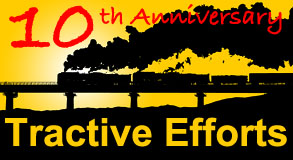
It's 10 years since my first website, Tractive Efforts, trundled onto the interweb in late 2002.
This feature looks at some of the many significant changes that have affected railways, photography, the internet and Railography over the last decade.
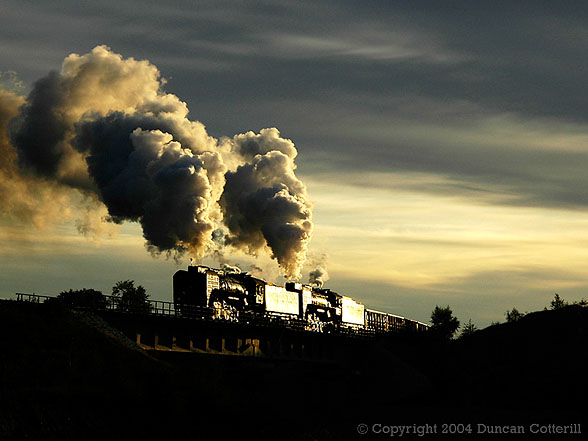
Main Line Steam Finale:
China's JiTong Railway was the world's last steam worked main line but had completely dieselised by the end of 2005. A year before the end, QJ 7007 and QJ 7119 met the sunrise at Sandi on the east side of Jingpeng Pass.On the Rails
In China there was still a little steam on the main line in 2002 and the JiTong railway rostered around 100 QJ class 2-10-2s on freights and passenger trains over a 600 mile route across Inner Mongolia. In the industrial sector, steam locomotives were the norm with hundreds in use daily at coal mines, steelworks and other large industrial plants across the country.
China Railway retired its last steamers in the summer of 2003 and the JiTong had gone completely diesel by the end of 2005. By late 2012, main line steam was but a distant memory and only a handful of industrial operations survived. Dieselisation had taken its toll but many rail operations had closed altogether and the final few are living on borrowed time. The last fires are likely to have been dropped long before Railography's 20th birthday.
Across the world the rush to replace loco hauled passenger trains with soulless multiple units continues apace, especially in Europe. The last decade has seen the virtual extinction of diesel hauled passenger trains in many European countries, partly due to replacement by DMUs and partly due to continuing electrification. There aren't many unwired routes left that have enough passengers to justify the provision of locomotive hauled trains.
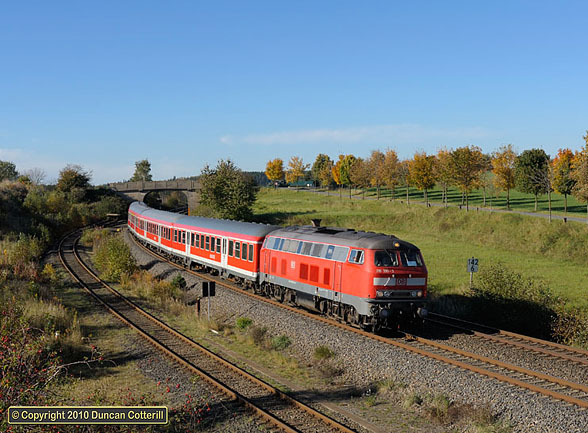
Disappearing Diesels:
Diesel hauled passenger trains are edging towards extinction in Europe. In October 2010 218.390 worked west from Reuth with RE3707, one of the last loco hauled services on DB's Reichenbach - Hof line.Electrification and the spread of the hideous class 66s have eliminated many of the most interesting diesel freight workings. Many operators have a policy of routing long distance traffic over the electrified trunk network, despite the existence of shorter diesel worked alternatives, some even rub salt in the wounds by routinely using diesel haulage under the wires for long distances.
Electric locos have fared much better than diesels and can still be found on passenger trains in most European countries, although they are rapidly losing ground to EMUs everywhere.
Electric freight operations have gone from strength to strength in some places, such as Germany, while withering in others, particularly France. Independent operators have brought variety as well, further enlivening the scene. There are even some attractive modern electric locomotive designs coming through, with all the major European builders having improved the looks of the locos they offer recently.
Electric locos have fared much better than diesels and can still be found on passenger trains in most European countries, although they are rapidly losing ground to EMUs everywhere.
Electric freight operations have gone from strength to strength in some places, such as Germany, while withering in others, particularly France. Independent operators have brought variety as well, further enlivening the scene. There are even some attractive modern electric locomotive designs coming through, with all the major European builders having improved the looks of the locos they offer recently.
Digital Revolution
Photography has seen amazing changes over the last decade. Digital cameras have gone from expensive curiosities to mainstream photographic tools and the technology continues to improve at an amazing rate. Use of film has dropped dramatically and Kodak, the most famous name in the business, appears to be on the verge of going under.
In 2002 6 Megapixels was the best resolution available in a mainstream digital camera but pixel counts have increased steadily ever since, with the Nikon D800 currently leading the field with a 36MP sensor. I've still no idea why anyone needs a 36MP sensor but that's progress.
While megapixels have hogged the headlines, the most significant improvements have been elsewhere with increases in dynamic range, reductions in image noise and the introduction of full-frame sensors having a much bigger effect on image quality than the number of pixels.
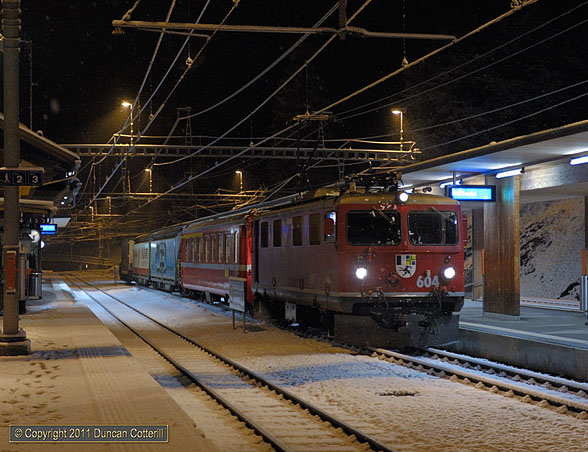
No Tripod Required:
RhB Ge4/4i 604 waited to leave Filisur with the early morning mixed to Samedan in February 2011, shot at 1/60s at f4 on 1600 ISO. Handheld night shots are now a reality and camera sensors are still getting better. It's not beyond the bounds of possibility that shooting fast moving trains at night becomes a practical possibility over the next decade.Over the same period, camera prices have dropped significantly. A digital SLR body would have set you back around £3000 prior to 2002. The Fuji S2 Pro broke the £2000 barrier for the first time and it wasn't long before DSLRs could be bought for under £1000. Prices continued downwards and the cheapest models now retail for under £300, less than 10% of the cost 10 years ago, but you have to pay a bit more to get the sort of specification needed for top quality photography. Like them or loath them, digital cameras are here to stay.
Cameras have also become more useable with much improved battery life, almost instantaneous start up, imperceptible shutter lag and a greater range of useable ISO settings. In every respect, current DSLRs match or outperform their film counterparts. What has hardly changed is the basic form, which still closely resembles that of a film SLR, even down to the pentaprism, mirror and mechanical shutter. Other forms have been introduced and some have found a niche in the market but the interchangeable-lens SLR format still reigns supreme in the realm of serious photography.
The Fuji S2 was the first digital camera that passed my requirements for usability and image quality and joined the roster in early 2003. At that time there was no intention to stop using film and the S2 was only intended to be used when there wasn't time to set up the medium format Pentaxes. It didn't work that way and before long the Fuji was being used for the vast majority of pictures. By mid 2004 the Nikon D70 was out and it made sense to get one and leave the medium format kit at home, a decision that pleased my aching back no end. I haven't taken anything on film since.
Cameras have also become more useable with much improved battery life, almost instantaneous start up, imperceptible shutter lag and a greater range of useable ISO settings. In every respect, current DSLRs match or outperform their film counterparts. What has hardly changed is the basic form, which still closely resembles that of a film SLR, even down to the pentaprism, mirror and mechanical shutter. Other forms have been introduced and some have found a niche in the market but the interchangeable-lens SLR format still reigns supreme in the realm of serious photography.
The Fuji S2 was the first digital camera that passed my requirements for usability and image quality and joined the roster in early 2003. At that time there was no intention to stop using film and the S2 was only intended to be used when there wasn't time to set up the medium format Pentaxes. It didn't work that way and before long the Fuji was being used for the vast majority of pictures. By mid 2004 the Nikon D70 was out and it made sense to get one and leave the medium format kit at home, a decision that pleased my aching back no end. I haven't taken anything on film since.
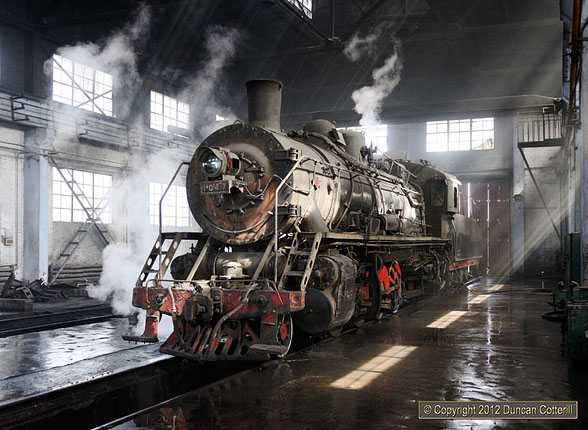
Difficult Lighting:
Digital excels in the sort of difficult lighting conditions that tend to fool lightmeters. A couple of test shots and a check of the histogram will ensure the exposure is correct. If you're using film it's much more difficult to be sure that you've got it right. SY 1047 raised steam in the workshop at Baiyin, China in March 2010.There are still those that argue that digital camera images are inferior to film and to some extent they have a point. In ideal conditions film may produce slightly better images but conditions are rarely ideal except in a studio. In the real world, a digital camera's inherent flexibility and its ability to provide instant feedback more than make up for any shortcomings, particularly in the sort of difficult lighting conditions that often produce the most memorable images. Digital has other advantages as well and I certainly don't miss the hassle of trying to get film through airport security without it being fried or the risk that the lab would destroy my precious pictures when they were only meant to develop them. I certainly wouldn't go back to film willingly.
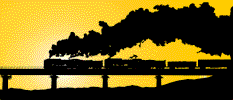
The original Tractive Efforts logo from 2002 featured a pair of QJs on Reshui Viaduct
Tractive Efforts & Railography Logos Past & Present

The original Railography logo from 2003 introduced the filmstrip motif


The 2008 logo came in two versions, one featuring a GE Dash 8 on the Santa Fe and the other a Czech class 751, both framed in the lens of a camera

When Tractive efforts was combined with Railography in 2006 a cast nameplate in the style of those fitted to British Rail diesels was used as the logo
The 10th anniversary refresh returns to steam with a QJ on the main logo
and a sunset background merging into the filmstrip motif.
There's also a QJ on a secondary stamp logo
and a sunset background merging into the filmstrip motif.
There's also a QJ on a secondary stamp logo
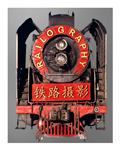
On the Web
The Internet was a very different place in 2002. There was no Facebook or Twitter and nobody had heard of social media. Big business hadn't really come to terms with the internet's potential and selling online was largely the preserve of specialist retailers. How things have changed!
At the time it was conceived, Tractive Efforts was only intended as an outlet for my Chinese steam trip reports and was hosted on the free webspace provided by my ISP. The site quickly expanded to include photo galleries and soon outgrew the space available.
Keeping everything small and simple was vital. Large files took an eternity to load when most people were using 56k modems and the whole website had to be crammed into a few MB of webspace anyway. The switch to broadband and the emergence of cheap web hosting packages offering Gigabytes of space have made rich content and large sites practical.
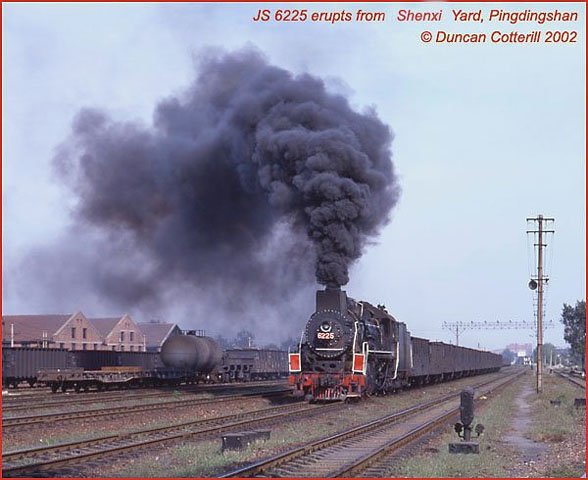
First Report:
My first foray into web publishing was the report of a September 2002 trip to China that included this picture of JS 6225 on the Pingdingshan coal mining system.Moving the site to a new home involved choosing a URL but using the name tractive efforts was problematic. It wasn't really snappy enough and there was plenty of scope for confusion over how the two words were connected, so Railography was born with Tractive Efforts continuing as a section of the site covering China.
After a while it became clear that there was little logic in separating the site content into China and the rest, so Railography absorbed Tractive Efforts in late 2006. The combined site has continued to grow and now hosts over 2800 photos, almost 100 trip reports and details of over 7200 Chinese steam locomotives.
To mark the completion of 10 years, the website's been given a refresh, increasing the space for content on each page and adding flexibility to the layout, as can be seen here. More new features are planned over the coming months. If you miss the menus that always appeared in the filmstrip at the side of each page, don't worry, all the links that were there can now be found elsewhere, either towards the foot of the page, under the "Block Section" header, or at the top of index pages.
There's one thing on the web that hasn't changed since 2002, Internet Explorer 6. It's over 10 years old and doesn't come close to complying with modern web standards but some people still insist on using it.
Railography's new look relies on features not supported by IE6 so pages may not render correctly if you insist on using it.
Who knows what the next ten years has in store for railways, photography, the web or Railography? Hopefully it will be as interesting and inspiring as the last decade and there will be plenty of new material to add to the site. I might even get around to scanning some of the thousands of medium format transparencies that have been hiding in the cupboard since I went digital.
After a while it became clear that there was little logic in separating the site content into China and the rest, so Railography absorbed Tractive Efforts in late 2006. The combined site has continued to grow and now hosts over 2800 photos, almost 100 trip reports and details of over 7200 Chinese steam locomotives.
To mark the completion of 10 years, the website's been given a refresh, increasing the space for content on each page and adding flexibility to the layout, as can be seen here. More new features are planned over the coming months. If you miss the menus that always appeared in the filmstrip at the side of each page, don't worry, all the links that were there can now be found elsewhere, either towards the foot of the page, under the "Block Section" header, or at the top of index pages.
There's one thing on the web that hasn't changed since 2002, Internet Explorer 6. It's over 10 years old and doesn't come close to complying with modern web standards but some people still insist on using it.
Railography's new look relies on features not supported by IE6 so pages may not render correctly if you insist on using it.
Who knows what the next ten years has in store for railways, photography, the web or Railography? Hopefully it will be as interesting and inspiring as the last decade and there will be plenty of new material to add to the site. I might even get around to scanning some of the thousands of medium format transparencies that have been hiding in the cupboard since I went digital.
